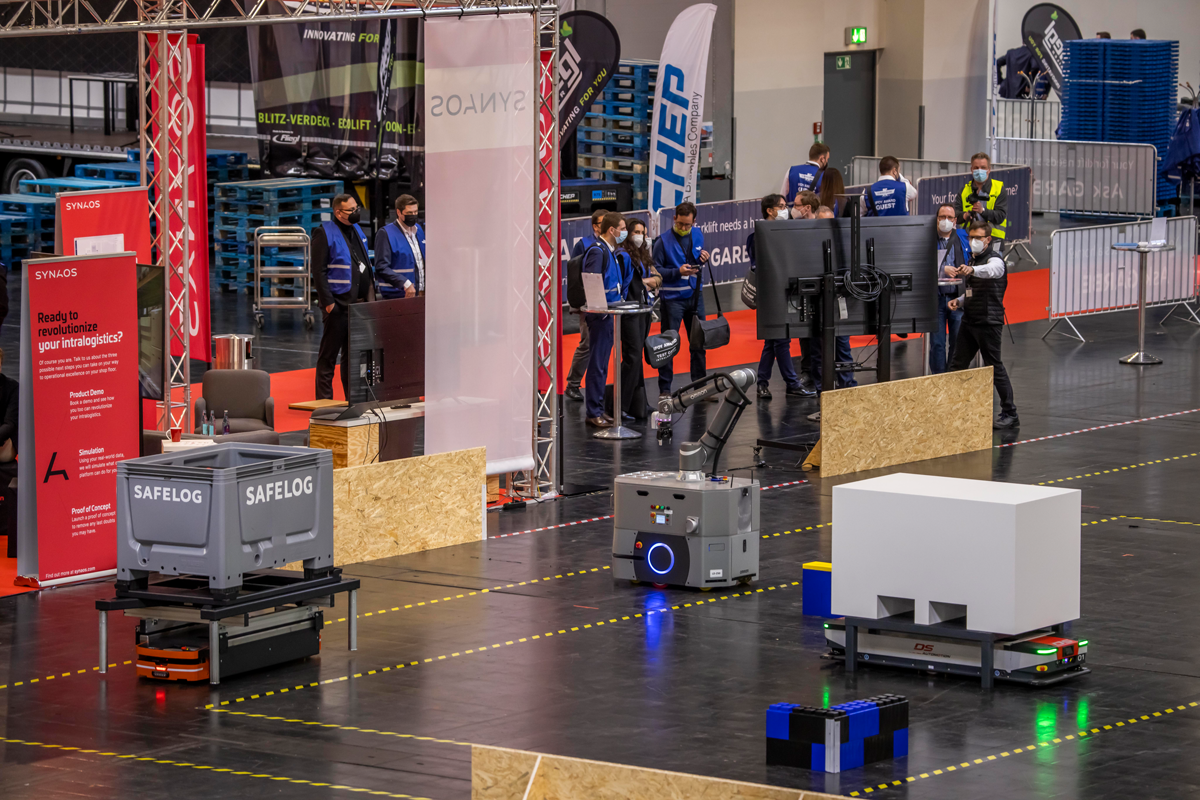Unified communication with VDA 5050
Laden Sie unseren Kalender herunter
Schritt 1:
Öffnen Sie Ihren Kalender in Outlook unter https://outlook.office.com/calendar.
Unter Windows können Sie auch Ihr Outlook-Programm nutzen. Die nötigen Schritte weichen dann ggf. leicht ab.
Schritt 2:
Klicken Sie auf Kalender hinzufügen und wählen Sie Aus dem Internet abonnieren.
Schritt 3:
Fügen Sie folgenden Link ein und klicken Sie auf Importieren.
https://outlook.office365.com/owa/calendar/d35c67af88f64628a6018dbceff8877f@synaos.com/8d78e80490b8462db720d7687cbe5c204542545792701501371/calendar.ics
Geschafft! Ab sofort profitieren Sie von unsere Events-Kalender und sind immer über die aktuellsten Intralogistik-Events in 2024 informiert.
Schritt 1:
Öffnen Sie Google Calendar unter http://calendar.google.com.
Schritt 2:
Gehen Sie in die Einstellungen und klicken Sie unter Kalender hinzufügen auf Per URL.
Schritt 3:
Fügen Sie folgenden Link ein und klicken Sie auf Kalender hinzufügen.
https://outlook.office365.com/owa/calendar/d35c67af88f64628a6018dbceff8877f@synaos.com/8d78e80490b8462db720d7687cbe5c204542545792701501371/calendar.ics
Geschafft! Ab sofort profitieren Sie von unsere Events-Kalender und sind immer über die aktuellsten Intralogistik-Events in 2024 informiert.
Wenn Sie kein Outlook oder Google Calendar nutzen, funktioniert das Hinzufügen des Kalenders ggf. etwas anders. Sie können diese allgemeinen Schritte befolgen, um unseren Events-Kalender Ihrem Kalender-Programm hinzuzufügen.
Bei Schwierigkeiten können Sie auch Ihre IT-Abteilung um Hilfe fragen.
Schritt 1:
Öffnen Sie Ihr Kalender-Programm.
Schritt 2:
Navigieren Sie zu der Stelle in Ihrem Programm, an der Sie einen Kalender hinzufügen können. Dies ist häufig in den Einstellungen oder der Menüleiste zu finden.
Schritt 3:
Wählen Sie die Option, bei der Sie einen Kalender aus dem Internet/per URL (oder ähnlich) abonnieren können und fügen Sie an der Stelle folgenden Link ein.
https://outlook.office365.com/owa/calendar/d35c67af88f64628a6018dbceff8877f@synaos.com/8d78e80490b8462db720d7687cbe5c204542545792701501371/calendar.ics
Geschafft! Ab sofort profitieren Sie von unsere Events-Kalender und sind immer über die aktuellsten Intralogistik-Events in 2024 informiert.

The VDA 5050 is a standardized communication interface between driverless vehicles and the backend software, i.e. the central control system. The standard provides for a uniform data language and determines how orders, card data, AGV states and errors are communicated. The standard even requires a technical implementation.
This standardization of communication between hardware and software allows the operation of manufacturer-independent fleets. On the shop floor, AGVs, AMRs and other vehicles from different manufacturers can therefore do their work together — controlled and optimised from a central location. For users, more heterogeneity brings major financial savings and unprecedented flexibility. And thanks to standardization, efficiency and quality are increasing.
Collaborative Approach
This standardization was initiated by the Association of the Automotive Industry. In addition to automotive manufacturers, AGV manufacturers are also involved in the preparation, specifically the VDMA Conveyor Technology and Intralogistics Association. As a project team, experts are developing the standard, including the Karlsruhe Institute of Technology (KIT) and SYNAOS.
The new interface ensures that “plug & play” can also become a reality in intralogistics and production: A new vehicle should be able to connect quickly to an existing system and take on transport orders. There are no high implementation costs.
Plug & Play in industry
This principle has long been the norm in many areas of consumer electronics. Users can simply plug in a new printer to the PC via USB and no longer have to worry about installing and configuring drivers because the operating system does everything. In intralogistics, new AGVs, other vehicles and mobile robots should be integrated into a fleet as quickly as possible and ready to go. In this way, a heterogeneous fleet can be created in a short period of time and continue to grow without any problems. A national standard should better position German manufacturers worldwide: AGVs from German manufacturers should also be able to be put into operation quickly in China.
VDA 5050 is standard with SYNAOS
“VDA 5050 Onboarding” is an important part of a typical project process at SYNAOS. It enables hardware manufacturers to implement the VDA 5050 as efficiently and qualitatively as possible on an AGV, for example. SYNAOS has also developed validators for subsequent analysis and verification of communication. SYNAOS has a broad AGV partner network to successfully distribute the VDA 5050.
At the end of 2019, SYNAOS successfully controlled autonomous vehicles from the cloud on its own land based on the VDA 5050. The new interface was able to pass a first public live test at the AGV Mesh-Up in March 2021. There, a central control system controlled autonomous vehicles from six different manufacturers extremely reliably.
The number of intralogistics providers using the VDA-5050 standard has already grown significantly. In the future, all participants want to continue the open source and community approach of VDA 5050. The source code is also to be published on the GitHub development platform in order to promote rapid development. The VDA-5050 standard is also to be incorporated into the DIN and ISO standards in the future and thus gain international recognition.
Schließen Sie sich 1.000+ Intralogistik-Insidern an, die Insights direkt per E-Mail erhalten.





